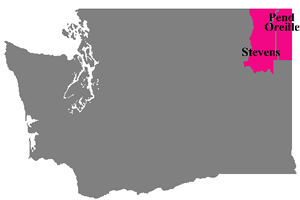 |
 |
 |
 |


Fact Sheet #03:
Case studies examining the economic impacts of the Forests and Fish
rules on NIPF landowners in Eastern Washington.
|
2001 By Elaine Oneil Save or Print a PDF copy of Fact Sheet #03
Rather than evaluating broad trends, case studies look at specific impacts on an individual basis; a method that demonstrates the significant variability in impacts across small ownerships. The Eastern Washington case studies will include an evaluation and comparison of riparian management options between the new legislative requirements and the previous rules, as well as an examination of alternative plans as provided for within the revised regulation package. The examination of alternative plans will help reveal potential unintended ecological consequences of the new rules. In Eastern Washington, the Forests and Fish rules restrict timber
harvest in a three-zone riparian buffer along any potentially fish-bearing
streams. No harvesting is allowed in zone closest to the stream.
Harvest may be allowed in the middle zone as long as certain minimum
basal area, tree count, and tree size requirements are met. Harvesting
is generally allowed in the outermost zone subject to specific leave
trees requirements. Riparian management requirements vary by timber
habitat type. Within the legislation, timber habitat type is defined
by elevation, not by existing tree species or land capability.
Preliminary Evaluation Key elements emerging from this evaluation of the impacts of the new regulation include significantly greater landowner limitations to manage for risks associated with insects, disease, and fire. These risks are currently prevalent in Eastern Washington forests even more so than in earlier history. In contrast to the Western Washington requirements to aim for a desired future condition that can be projected with existing growth models, Eastern Washington riparian management is intended to provide for conditions that vary over time. Modeling of forest stand development through time, given present conditions, indicates that it may not be possible to develop a healthy, resilient seral species mix within the framework of the current riparian requirements. Alternative planning strategies, which are permitted under the forest and fish rules, provide a possible method to meet both riparian functional requirements and establish healthy, resilient eastside forests. Economic analysis on the six case studies is in progress. Specific
elements emerging from the analysis include a change in the relative
components of sawlog, hew saw, and pulp wood that can be removed
from riparian forests. This change in the ratio of products combined
with their respective price differentials may render future treatments
uneconomical under the forest and fish rules. Alternate plans that
provide equivalent environmental protection through more selective
management are being developed and may be able to reduce negative
economic impacts.
|



